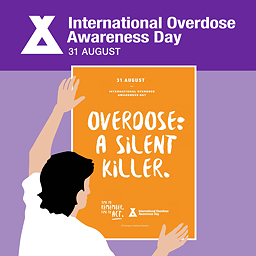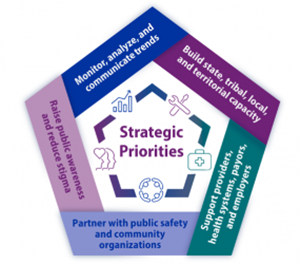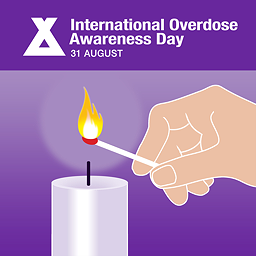Home > PTTC Post Article - August 2023
Author: Cele Fichter-DeSando, MPM
August 31st is International Overdose Awareness Day (IOAD). This global event is part of a campaign to end overdose, remember those who have died (without stigma), and acknowledge the grief of the family and friends left behind. The overarching theme of IAOD each year is Time to Remember. Time to Act.

I began to learn about using desktop computers in the late 1970s and early 1980s. I was a slow learner. I remember asking questions about what new functions and capabilities were available to me. A frequent response to my “Why can’t I do this?” question was “You don’t have enough memory for that function.” I didn’t learn much about computers but I did learn that the size of the memory was often directly proportionate to the capability and functions available. The “Time to Remember. Time to Act.” theme of IAOD highlights what I learned about computers. In order to be capable of action, we have to have a big enough memory. We have to have the courage and capacity to remember. We can’t move forward in overdose prevention and future planning if we don’t understand and acknowledge overdose deaths and take the time to remember and grieve those who have been lost.
The goals of IOAD are to :
A 2023 IOAD Campaign Kit is available to help with event planning and promotion including posters, social media tiles and banners, t-shirt designs, Zoom backgrounds, and other digital assets.
According to provisional data from the Centers for Disease Control and Prevention (CDC), of the more than 107,600 reported drug overdose deaths in 2021, more than three-quarters were attributed to opioids. Additionally, in 2020 there were more unintentional overdose deaths in the workplace than in any other year since data collection began in 2011 (NSC, 2023). The recently released CDC report Estimates of Drug Overdose Deaths Involving Fentanyl, Methamphetamine, Cocaine, Heroin, and Oxycodone: United States, 2021 analyzes overdose deaths by drug, age, sex, race, and public health region to guide research, prevention, and treatment efforts (Spencer et al., 2023). The National Institute for Health Care Management (NIHCM) provides interactive graphics to help users understand how overdose deaths involving opioid use have not only grown in magnitude since 2000 but have also changed in character (NIHCM, 2022).

Prevention Professionals with their strength and experience in collaboration, implementing evidence-based programs, and technology transfer are key to awareness campaigns and are skilled at helping communities and organizations remember and act.
A model for designing overdose awareness programs is the CDC's Efforts to Prevent Overdoses and Substance Use-Related Harms which is guided by six principles and five strategies in its mission to prevent overdoses and reduce substance use-related harms. Overdoses impact families, communities, workplaces, and the economy, multifaceted guiding principles and strategic priorities are necessary to address the widespread impact.


The Substance Abuse and Mental Health Services Administration (SAMHSA) identifies harm reduction as a key pillar in overdose prevention. Harm reduction emphasizes engaging directly with people who use drugs to prevent overdose and infectious disease transmission; improve physical, mental, and social well-being; and offer low-barrier options for accessing health care services, including substance use and mental health disorder treatment.
New legislation for 2023 opens opportunities to provide treatment for those in need of opioid use disorder (OUD) services to the approximately 1.9 million practitioners across the country with registration from the Drug Enforcement Administration (DEA) to prescribe controlled medications. The Consolidated Appropriations Act of 2023 Sections 1262 and 1263, respectively, eliminate the DATA waiver previously needed to prescribe buprenorphine and installs new Training Requirements (MATE Act) Resources for substance use disorders for all DEA registered practitioners, except veterinarians. These sweeping changes lay the foundation for a dramatic increase in access to medications for opioid use disorders (MOUD) to help the thousands of individuals in need of services, help to prevent overdoses, and save lives.
National Safety Council (NSC) outlines several steps that your organization can take to further the efforts of overdose awareness with both remembrance and call-to-action activities.


Center for Disease Control and Prevention (CDC), 2022. Overdose Prevention. CDC, 2022. https://www.cdc.gov/drugoverdose/prevention/index.html
National Safety Council (NSC), 2023.
Make a Difference On International Overdose Awareness Day. National Safety Council. 2023. https://www.nsc.org/community-safety/safety-topics/opioids/overdose-awareness-day
National Institute for Health Care Management (NHCM), 2022. Visualizing the Impact of the Opioid Overdose Crisis. July 28, 2022.
https://nihcm.org/publications/visualizing-the-impact-of-the-opioid-overdose-crisis
Spencer MR, Warner M, Cisewski JA, Miniño A, Dodds D, Perera J, Ahmad FB. Estimates of drug overdose deaths involving fentanyl, methamphetamine, cocaine, heroin, and oxycodone: United States, 2021. Vital Statistics Rapid Release; no 27. Hyattsville, MD: National Center for Health Statistics. May 2023. DOI: https://dx.doi.org/10.15620/cdc:125504. (05/2023)